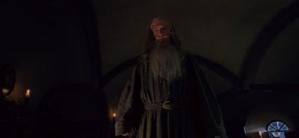The film Lord of the Rings: The Fellowship of the Ring, uses the traditional three-point style of lighting throughout the movie. The major scenes in the movie that set up what the movie is about and the different editing with the lighting that goes on with the movie in different parts of the movie draw the audience in, but at the same time shows throughout the different kinds of lighting used as well. Sometimes the lighting in the background uses the third part of the three-point lighting scheme. When using this it shows the characters as Goodykoontz and Jacobs say, “The reason is that the bright rim of light visible from the camera position (sometimes called rimlight) makes the actors “pop-out” from the background” (Goodykoontz & Jacobs, 2014). This will make the people watching the movie see the character more than its background. In this scene, Gandalf bids a goodbye to Bilbo and Gandalf has to become a giant of a character showing him with the rimlighting as he talks to Bilbo. This also shows a little bit of underlighting as well. It gives Gandalfs character a scary look as we see Bilbo becoming terrified of Gandalf.
The benefits of this style of lighting is what makes the scene I used as an example forthcoming. It provides us as viewers with the sense of a power and a fear needed to get a certain point across to Bilbo. There are so many different scenes in this movie that are only going to show the audience how it will effect the different types of mood of the characters within the theme that it is trying to portray. The benefit of the three-point lighting is needed to bring to the audience meanings to different aspects of the movie. It brings the audience an emotion towards the characters as well as the evil that is trying to destroy Middle Earth and we also see the greatness of good trying to overcome the evil that surrounds them at the same time.
The technique used in the lighting contributed to the film in a huge way. The way the cinematographer had to use the different angles of the cameras to get certain shots he needed to bring the scenes and the story together. The different angles the cameras take, affects the lighting and the shots that the director wants for the film.
The three-point lighting is suited to be used all over the film and has different uses for the shots on the scenes that are being brought to the audience. The bright key light as well as the fill light is used all over this film to help the audience try to feel the emotion and excitement they are trying to portray throughout the movie, with each character having his or her own fight. Whether it be an inside battle the character is facing or the problems being solved by the characters with each shot and take this technique and style of lighting helps the whole movie come together with meaning and emotion. It shows the style the movie is trying to get across to the viewers. If any other lighting technique that is used, would not help you understand what is going on within the movie or how it is being played out.
If there was any different style of lighting used on this scene portraying Gandalf becoming a larger more scarier character at the single most important part of this scene to help the viewers understand the importance of what is going on. If you used the high-key lighting, it would have taken away the emotion and fear of the scene the cinematographer was trying to portray during this certain scene. Not having a shadow effect as well as back lighting, the scene would not be able to make the scene feel an emotion of fear and yet caring in the end.
Cecchini, M., & Crow, D. (2014). Gandalf Goes Scary on Bilbo [online image]. Retrieved from http://www.denofgeek.us/movies/middle-earth/242154/70-fantastic-moments-in-peter-jacksons-hobbit-and-lord-of-the-rings-films
EgalmothOfGondolin01 (2012, December 15). LOTR The Fellowship of the Ring-Farewell Dear Bilbo . Retrieved from https://www.youtube.com/watch?v=4YyOpPTrHlk
Goodykoontz, B., &Jacobs, C. P. (2014). Film: From Watching to Seeing (2nd ed.). San Diego, CA: Bridgepoint Education, Inc.
